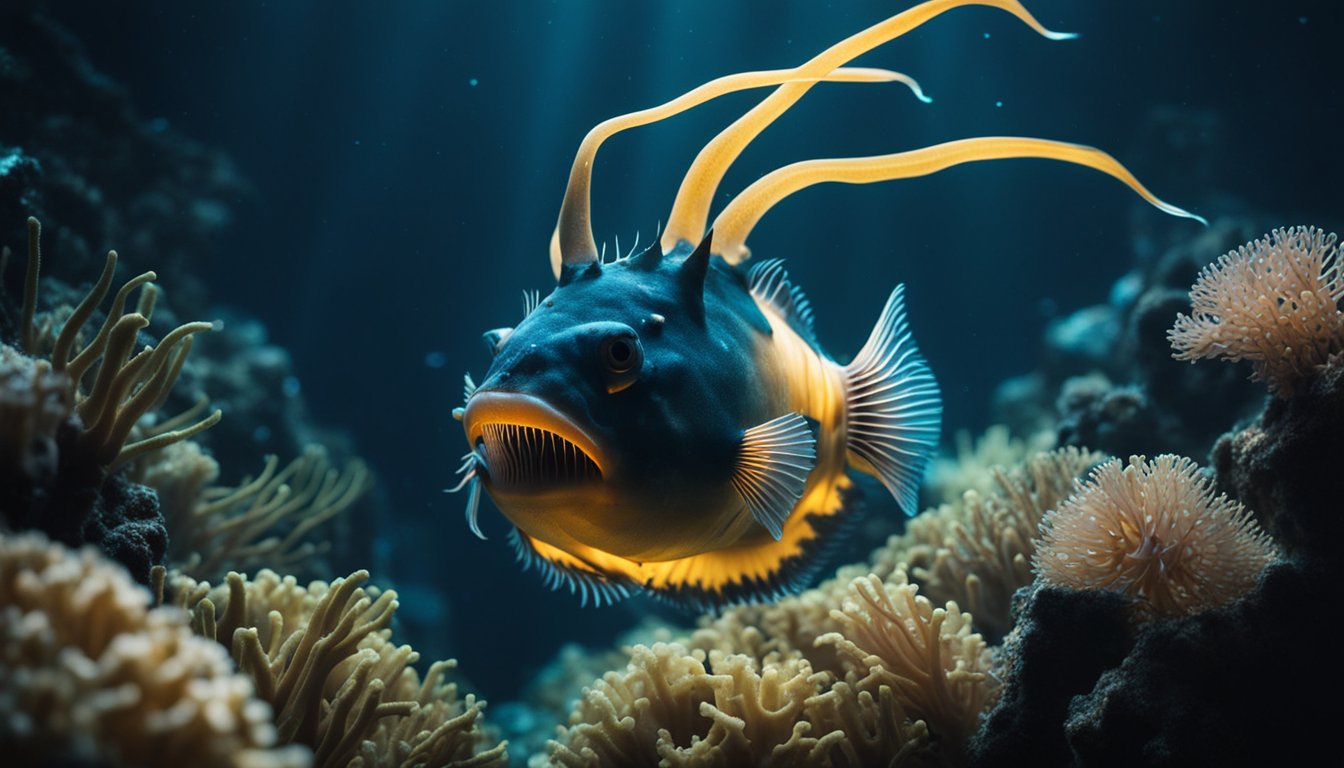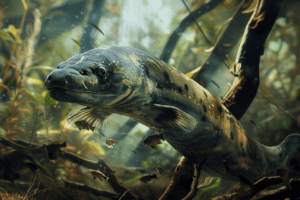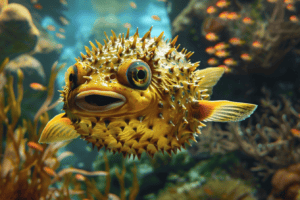Deep in the ocean’s depths, a world of strange and fascinating creatures awaits discovery.
One such creature is the anglerfish, a deep-sea dweller with a unique method of survival.
With its glowing lure and sharp teeth, the anglerfish is a master of the dark, cold waters it calls home.

Despite its fearsome appearance, the anglerfish is a fascinating creature with many unique adaptations.
In this article, we will explore the strange life of the anglerfish, from its unusual mating habits to its incredible ability to survive in one of the harshest environments on Earth.
Join us as we dive into the depths of the ocean and discover the secrets of this mysterious creature.
Mysterious Hunters of the Deep

The anglerfish is a deep-sea dweller that belongs to the order Lophiiformes, which includes over 300 species.
These fish are known for their unique hunting strategy and bizarre physical appearance.
Here are some interesting facts about these mysterious hunters of the deep.
Lure and Light: The Anglerfish’s Hunting Strategy
One of the most distinctive features of the anglerfish is its bioluminescent lure.
This is a fleshy protrusion that extends from the fish’s head and emits a bright light.
The lure is used to attract prey, which mistake it for a small fish or shrimp.
Once the prey gets close enough, the anglerfish opens its large jaws and swallows it whole.
The anglerfish’s lure is not the only source of light in its dark habitat.
The fish’s skin also contains light-producing organs called photophores.
These organs help the anglerfish blend in with its surroundings and avoid being seen by predators or prey.
Camouflage and Adaptation
In addition to its hunting strategy, the anglerfish is also well-adapted to life in the deep sea.
Its body is flattened and wide, which helps it to move more easily through the water.
The fish’s skin is also covered in tiny spines, which provide it with protection against predators.
Another interesting adaptation of the anglerfish is its ability to change color.
Some species can change their skin color from brown to black, depending on the depth of the water they are in.
This helps them to blend in with their surroundings and avoid detection.
Overall, the anglerfish is a fascinating creature that has adapted to life in the deep sea in unique and unusual ways.
Its hunting strategy and physical appearance make it one of the most mysterious and intriguing creatures of the ocean depths.
Anatomy of the Anglerfish
Unique Bodily Features
Anglerfish are a peculiar type of fish that live in the deep sea. They have several unique features that set them apart from other fish.
One of their most distinguishing features is the presence of a long, thin, and fleshy appendage that protrudes from their head.
This appendage is called the illicium, and it is used as a lure to attract prey.
In addition to the illicium, anglerfish have a large head and a small body.
They also have a hinged jaw that allows them to swallow prey that is much larger than their own body.
Their teeth are sharp and pointed, which helps them to hold onto their prey.
Another unique feature of the anglerfish is their ability to change color.
They have special cells in their skin called chromatophores, which allow them to blend in with their surroundings.
This helps them to avoid predators and sneak up on prey.
The Role of Bioluminescence
Anglerfish are also known for their ability to produce light. They have a special organ called the photophore, which produces bioluminescence.
This light is used to attract prey to the illicium.
Some species of anglerfish have bioluminescent bacteria living in their photophores.
The bacteria produce the light, which is then used by the anglerfish to attract prey.
Other species of anglerfish produce their own light using a chemical reaction.
The bioluminescence of the anglerfish is not just used for hunting. It is also used for communication between members of the same species.
Male anglerfish have a special organ that produces bioluminescence, which they use to attract a mate.
In conclusion, the anatomy of the anglerfish is fascinating and unique.
Their illicium, hinged jaw, sharp teeth, and ability to change color make them well-suited for life in the deep sea.
Their bioluminescence is also a remarkable adaptation that helps them to survive in this challenging environment.
Reproduction and Lifecycle

Mating Rituals
The anglerfish has one of the most unique mating rituals in the animal kingdom.
The females of the species are much larger than the males, and they use their bioluminescent lure to attract prey and potential mates.
When a male anglerfish finds a female, he bites onto her skin and gradually fuses his body to hers.
The male then loses his eyes, internal organs, and digestive system, becoming entirely dependent on the female for survival.
This process, known as sexual parasitism, allows the male to continuously provide sperm to the female, ensuring that she can reproduce whenever she is ready.
The male’s body essentially becomes a permanent sperm-producing organ for the female, and can remain attached to her for the rest of his life.
Growth and Development
After mating, the female anglerfish will lay her eggs in a gelatinous mass on the ocean floor.
The eggs hatch into larvae, which float to the surface and drift with the ocean currents.
These larvae undergo several stages of development before eventually settling on the ocean floor and transforming into adults.
As the anglerfish grows, its bioluminescent lure becomes more pronounced and effective at attracting prey.
The fish also develops a unique symbiotic relationship with certain species of bacteria, which live in a special organ in the anglerfish’s body and provide it with the ability to produce light.
Despite their strange and fascinating reproductive habits, anglerfish are threatened by habitat destruction and overfishing.
By learning more about these deep sea dwellers and their life cycle, we can better understand how to protect them and their unique ecosystem.
Anglerfish and Human Interaction

Despite their fascinating appearance and unique adaptations, anglerfish have not had much interaction with humans.
Due to their deep-sea habitat, they are rarely encountered by humans, and when they are, it is usually by deep-sea researchers or fishermen.
Scientific Research
Anglerfish have been the subject of numerous scientific studies due to their unique morphology and behavior.
Researchers have been particularly interested in the bioluminescent lure that the female anglerfish uses to attract prey and mates.
The study of this adaptation has led to the discovery of new species and a better understanding of the deep-sea ecosystem.
One of the most famous examples of anglerfish research is the discovery of the parasitic mating strategy in which the male anglerfish fuses to the female’s body and lives off her nutrients.
This discovery was made in the late 19th century by scientists who were studying the anatomy of anglerfish specimens.
Conservation Efforts
Due to their deep-sea habitat, anglerfish are not threatened by human activities such as fishing or pollution.
However, they are indirectly impacted by these activities through the destruction of their habitat and the depletion of their prey.
Conservation efforts for deep-sea ecosystems, including anglerfish habitats, are still in their early stages.
However, some organizations, such as the Deep Sea Conservation Coalition, are advocating for the protection of deep-sea habitats from destructive activities such as deep-sea mining.
Fun fact: The anglerfish is one of the few species that has been featured on a postage stamp.
In 1986, the United States Postal Service released a stamp featuring the anglerfish as part of its deep-sea creatures series.
Frequently Asked Questions

How do anglerfish light up the dark ocean depths?
Anglerfish have a unique adaptation that allows them to produce light in the dark ocean depths.
They have a modified dorsal fin called an illicium that protrudes from their head and has a bioluminescent lure at the end.
This lure, which is made up of bacteria, is used to attract prey in the deep sea.
The light produced by the bacteria is created through a chemical reaction known as bioluminescence.
What are the differences between male and female anglerfish?
Male and female anglerfish are vastly different in size and appearance.
Female anglerfish are much larger than males and have a distinctive illicium on their head.
Male anglerfish, on the other hand, are much smaller and lack the bioluminescent lure.
Instead, they have a keen sense of smell that allows them to locate females.
Once they find a female, they will bite onto her body and fuse with her, essentially becoming a permanent parasite.
How big can anglerfish grow, and how do they compare to human size?
Anglerfish come in a variety of sizes, with the smallest species measuring only a few centimeters in length and the largest species growing up to a meter in length.
This means that some anglerfish are smaller than a human hand, while others can be larger than a human torso.
However, despite their size differences, all anglerfish share the same unique characteristics that make them one of the most fascinating creatures in the ocean.
What kind of prey do anglerfish hunt in the deep sea?
Anglerfish are opportunistic predators that will eat almost anything that comes within reach of their jaws.
Their diet includes fish, crustaceans, and even other anglerfish.
However, due to the harsh conditions of the deep sea, food can be scarce, and anglerfish have adapted to survive long periods without food.
They have a slow metabolism and can go up to several months without eating.
Can you describe the habitat of deep-sea anglerfish?
Deep-sea anglerfish live in one of the most extreme environments on Earth.
They reside in the dark, cold, and high-pressure waters of the deep sea, where temperatures can be near freezing, and the pressure can be over 1,000 times greater than at the surface.
Despite these harsh conditions, anglerfish have adapted to survive in this environment and have developed unique characteristics that allow them to thrive.
Why are anglerfish often considered one of the most bizarre creatures in the ocean?
Anglerfish are often considered one of the most bizarre creatures in the ocean due to their unusual appearance and behavior.
Their large heads, sharp teeth, and bioluminescent lures make them look like something out of a science fiction movie.
Additionally, their unique reproductive strategy, where males fuse with females, is unlike anything seen in other animals.
All of these factors make anglerfish one of the most fascinating creatures in the ocean and a favorite of many marine biologists.









